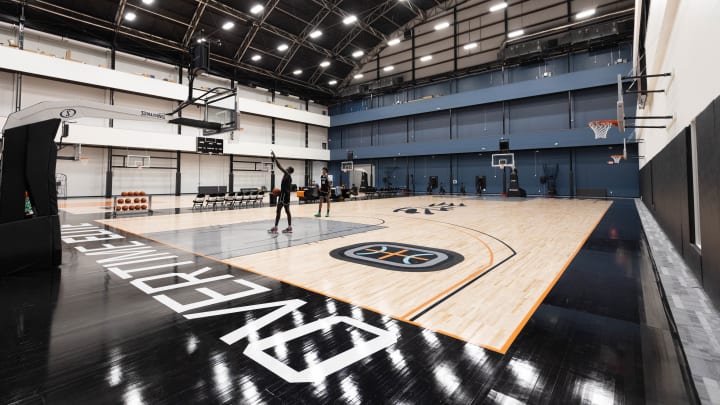Beyond the Buzzer: Overtime Elite's Blueprint for Success

Now in its third season of existence, Overtime Elite has emerged as a premier pathway for some of the world’s best young basketball talent. With that in mind, the success of the league was catalyzed by a previously existing entity and creative minds that approached the concept differently than most would have.
Long before Overtime Elite existed, the sports media empire Overtime became a household name with sports fans around the world that relied on its content to stay in the know and see all of the exhilarating plays and highlights happening each night. Dan Porter, Co-Founder and CEO of Overtime, was the key driver of it quickly becoming one of the most popular sports platforms in the world, working alongside his Co-Founder, Zack Weiner.
Overtime wasn’t Porter’s first experience as it related to being an entrepreneur in the tech startup space. Before launching Overtime, he started and built various businesses across the gaming and ticketing industries. Equally as important for his current endeavors, he spent the first part of his career working in non-profit education before that, really understanding how to best work with young people and establish a strong and meaningful mission.
Porter has already seen tremendous success with Overtime Elite, with a plethora of talent developing in this program and moving on to play professionally or at the top colleges in the country. Most recently, Amen and Ausar Thompson graduated from OTE, then went on to be selected fourth and fifth overall in the 2023 NBA Draft.
“You're so personally motivated,” Porter told Draft Digest in an interview. “Like when the Thompson twins got drafted, I cried. It was incredible to me. It was just like, somebody did something with us and it changed your life.”
While the end goal is often the easiest to measure — as athletes go through the Overtime Elite program and go on to do incredible things on the basketball court — what this league is doing goes beyond the individual player accolades. It’s about giving back to the game and providing for the players that may need this unique path to reach their full potential. The actual games are played on the court every Friday and Saturday night, but the real work happens Sunday through Thursday. With a state of the art facility and staff, these athletes truly get a professional experience on and off the court.
There’s many misconceptions about Overtime Elite and how it fits into the overall basketball landscape. While it’s been labeled as a disruptor in the industry since the inception of the league, it’s actually more of a compliment to the previously existing infrastructure.
“Understand how much we think about innovation. I think it’s going to be good for basketball overall,” said Porter. “I know, we're a disrupter or whatever people want to say. But the reality is we are partners with college basketball. We are partners with the NBA, and we gave them their fourth and fifth draft picks who are doing great. We're training them for free. I think people want us to be this crazy other thing. But I think we really have fit into the ecosystem in a number of different ways that I think, ultimately, is good for the game of basketball, because every sport is competing for its audience.”
For Overtime Elite to be as successful as it has been to date, much thought had to go into the purpose behind the league. From idea to execution, it took about 18 months for Porter and his team to really put together the initial on-court product. With that in mind, they almost reverse engineered the concept to ensure it was successful. Rather than starting by thinking about the athletes and gameplay itself, the focus and mission actually started with ensuring the experience was exactly what the fan wanted.
“I think that in sports in general, people are like, I'm gonna start a basketball league or I'm gonna start a football league. And it's all about what happens on the court,” Porter recalled. “To me, I start from the opposite side. I'm like, Who is the audience? Why do they want this product? Why do they care? How are their needs being met or not met? And how do we connect with them?”
Once Porter nailed down exactly how to make this league the best experience for the fans around the world, he also had to think about differentiating the journey for the athletes that would make the life-changing decision to move to Atlanta and start a new chapter in their lives. This would go beyond just developing basketball skills, as these players would spend their entire days with one another on the court, in school at the facility and even at league housing where all of the athletes stay together. It was about building a tailored approach that touched on every aspect of a player’s potential, upside and future.
“I was very focused on this idea of this diamond, where at the top is skills. Below that is this idea of basketball IQ. A lot of NBA players have told me they had long careers because they were able to take advantage of rookies who had high skills but didn't have a strong basketball IQ. And then the two other access points are really just what we call HPD — which is health, performance and development — and just really developing there. You can't be a shifty point guard if you can't move laterally. Then finally the mental game and just how to be coached, how to take criticism, how to sustain focus. I think just building a curriculum from the ground up around those things, rather than just being like, okay let's run wind sprints and do drills.”
This league will always get elite talent to walk through the doors and join the program with the proven track record Overtime Elite has already established. Fans will always come to the arena to watch these athletes take the court in person. But taking it a step further, really tapping into the human element and seeing the emotional ties to the teams and these athletes is how Porter knows OTE is doing what it was built to do. This is the measure of success for Overtime Elite.
“People say, how do you know you're successful? And I'm like, because the City Reapers beat the Cold Hearts in the final, and some kid in Iowa cries his eyes out because the Cold Hearts lost. All I have to do is reverse engineer my 57 years of fandom for the Philadelphia Eagles. I went to the Super Bowl and I cried when they won as a grown ass man. Like why do I feel that way? It's the weirdest business because your goals are like love.”
With the foundation of Overtime Elite being about the fan, the biggest fear of Porter and his team when planning for the launch in 2021 was around ensuring it was something the fans and spectators would care about. As such, really studying the future audience of the league was crucial. This is where his expertise really shined, honing in on some of the intricate details that would impact the success of the league.
“I mean, the most existential fear is like, is anybody gonna care? And that's every startup’s fear,” Porter said. “What was I most unprepared for? Oh, my God, I gotta fill the arena. In a town that is mostly a college football town that has three pro sports teams already, as well as multiple college sports teams. And not only do I have to fill the arena, I have to understand everything about Atlanta. The traffic patterns. What happens when it rains? What happens when it's sunny? What happens when the [Georgia] Bulldogs are playing? You know, all of these other things like that.”
Luckily for Porter, he had an advantage that very few others in the world that would want to launch a basketball league had. While Overtime Elite was set to be this new thing, Overtime as a sports media platform was already well established. As such, tapping into a worldwide network of fans from day one was heavily leveraged. When speaking with Marc Kohn — Chief Content Officer at Overtime — this was something he looked back on as a huge reason OTE has been so successful in such a short period of time.
“One of our advantages and why I know we're going to be successful with this is that when we built this, we already had something like 50 million plus followers,” Kohn told Draft Digest. “We built the distribution system. We knew that whether it was on Instagram, whether it was on TikTok, whether it was on YouTube, whether it was on Twitter, we knew that we had an audience that liked a product like this.”
Having a large following and fans of the sport is one thing, but actually getting them on board with this new concept and truly caring is another. This is where Porter really ensured he was intentional in every single detail when building Overtime Elite. Every decision they made was with the fan in mind.
“I think our secret sauce is that in everything we do, it’s holding up a mirror back to them [the fan] and saying we see you and you're our partner in this. Versus, we see you as somebody who needs to buy a season ticket, a jersey, League Pass or do anything else like that. They're not our customers. The fans are why we exist — they're our partners,” Porter said.
As the third season of Overtime Elite gets underway, the fan base that has been built is remarkable. Just last season, two of the league’s teams had already begun to compete with some of the biggest professional sports franchises in the country in terms of popularity.
“I think people don't understand how big our fan base is,” Porter exclaimed. “Like the five most watched teams on TikTok were Messi in Miami, the Lakers, the Philadelphia Eagles, the Cold Hearts and the City Reapers. Two of those teams didn't exist 24 months ago, and we made them. I think that people don't understand how big it is and the passion.”
The combination of business acumen and understanding the human element from his experience prior to launching Overtime Elite was really the difference in this league taking off as quickly as it has. Across a variety of sports, leagues have failed over the past decade or more, but OTE’s blueprint for success has been unlike any other with Dan Porter at the helm.
Want to join the discussion? Like Draft Digest on Facebook and follow us on Twitter to stay up to date on all the latest NBA Draft news. You can also meet the team behind the coverage.
